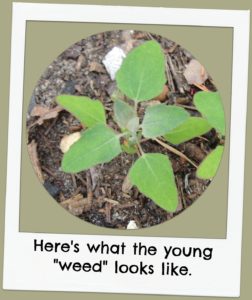Name: Lamb’s Quarters
Botanical Name: Chenopodium album
Form: wildflower
Parts Used: seeds
Citation: Guenther, K. (2017, January 12) Lamb’s Quarters as wildlife food [Web log post.] Retrieved: readers supply the date, from http://wildfoods4wildlife.com
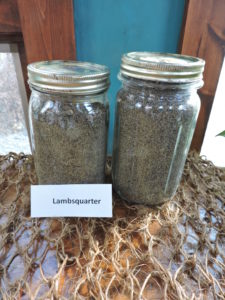
Getting Started
Liked by sparrows, and 34th on the Super Seeds List, lamb’s quarters is an important winter food for its seed, because it persists on the plant into winter. And new plants are easy to grow from seed—either seed you harvest yourself or purchased from companies that specialize in medicinal herbs. I’ve had luck growing a small stand of twenty or so lamb’s quarter plants in an area about the size of a large hula hoop. Makes it easy to harvest the stalks for seed in fall.
The amaranth/goosefoot family includes many plants rich in calcium. Like many weeds, they are found in disturbed soils, like gardens, flowerbeds, barnyards, cleared land. Small, inconspicuous greenish flowers cluster along the stems. Plants in this family can accumulate salts and nitrates from the soil where there is excess manure or chemical fertilization, even tasting vaguely salty at times, (Elpel, 2013) which is one reason to avoid eating the greens.
Lamb’s quarters is related to amaranth. Here’s the taxonomy:
Amaranthaceae (Amaranth/Goosefoot family)
Chenopodioideae (Goosefoot subfamily)
Chenopodium (Goosefoot genus)
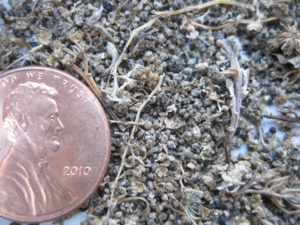
| Common name | Virginia Chenopodium species | Origin | Rare Plant Status |
| lamb’s quarters | C. album | non-native | not rare |
| pitseed goosefoot | C. berlandieri | native | Rare in some states (not Virginia) |
| Fogg’s goosefoot | C. foggii | native | Globally imperiled and critically imperiled in Virginia |
| oakleaf goosefoot | C. glaucum | non-native | not rare |
| nettleleaf goosefoot | C. murale | non-native | not rare |
| gray goosefoot | C. opulifolium | non-native | not rare |
| desert goosefoot | C. pratericola | native | not rare |
| Rocky Mountain goosefoot | C. salinum | native | not rare |
| mapleleaf goosefoot | C. simplex | native | Globally secure, vulnerable in Virginia |
| Standley’s goosefoot | C. standleyanum | native | Rare in some states (not Virginia) |

Key Features to Look For
In addition to using the identification guide of your choice, here are a couple of features you should see on this plant:
- Leaves lower on the stem are shaped a little like a goose footprint
- Small clusters of green flowers that look like mealy globules rather than like flowers
- Flowers are miniscule and look like clusters of little balls that then develop a reddish tinge as they mature
- Plant stalks have red vertical streaks when seeds are mature
- Plants mature at about waist to chest tall
Risks
None indicated for seed. Greens can accumulate nitrates and also can be cyanogenic. Few animals eat the greens, and I chose not to list this plant’s greens in this site’s database.
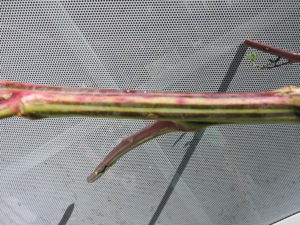
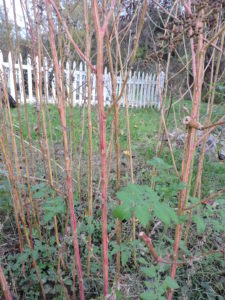
About This Species
Left to grow, lamb’s quarters can reach up to six feet tall in a good year and produce a good quantity of seeds. Some refer to this plant as pigweed, but pigweed is also a common name for other plants in the amaranth/goosefoot family.
Flower Description: Flowers form in dense clumps along the central spike and the branches of the plant. There are no visible flower petals.
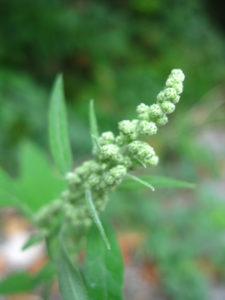
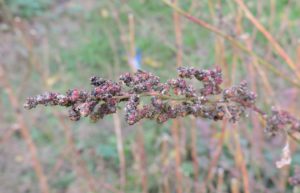
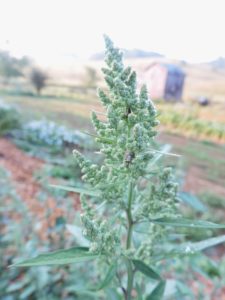
Leaf Description: The leaves are often triangular-ish and irregularly toothed and the larger lower leaves resemble a footprint of a goose!
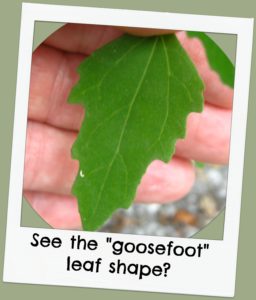
Seed Size: Very small, 3/64 inch (1 mm) diameter, but if you look with a hand lens you will see they are somewhat conical in shape like a very small version of common ragweed seeds.
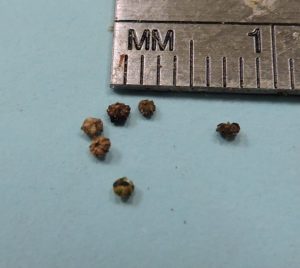
| Jan | Feb | Mar | Apr | May | Jun | Jul | Aug | Sep | Oct | Nov | Dec | ||||||||||||||
|---|---|---|---|---|---|---|---|---|---|---|---|---|---|---|---|---|---|---|---|---|---|---|---|---|---|
| winter | winter | late winter | early spring | spring | late spring | early summer | summer | late summer | early fall | fall | late fall | ||||||||||||||
| seed | x | x | x | x | |||||||||||||||||||||
Does this lend itself to being a good enrichment item? Maybe, unless you are concerned about introducing it as a weed species onto the rehab property. When plant is mature and starting to turn from green to brown, try cutting and installing whole plants in bird enclosures. Be gentle cutting and moving the plants so the seeds do not bump off prior to installation. By tying the plants up to the wall or cage, birds can glean seeds throughout the winter.
Harvesting Seed: Harvesting lamb’s quarter is very similar to harvesting ragweed or amaranth—tiny seeds. When the flowers have turned from green to pink/ red, start paying closer attention. When the flowers turn from pink/red to gray/brown, cut the lamb’s quarters plant into about two foot sections. Remove the leaves. Pack the stalks loosely and upside down in a five gallon bucket or an open plastic garbage bag tucking in all the side branches and do not tie the bag closed for air circulation. Let it all dry in the bucket/bag inside until everything is crispy dry. Then, working over a sheet— many seeds will have already fallen off in bucket or bag—strip each of the dry flower spikes between your thumb and forefinger to dislodge the seeds—sometimes you can just roughly crunch the seed heads of multiple stems at once in your hands and they will fall off. Transfer the seeds and small plant bits into another bucket. Shake and wiggle the bucket so the seeds fall to the bottom and the unwanted dry stems rise to the top. Hand pick the stems off and discard. Then use a colander or series of sieve screen meshes to further separate the seeds from the debris. I stop at this point and let the animals finish the work, if they care to. If you feel you must, you can clean the seeds further from the unwanted plant bits and dust by winnowing what is left, but you might start losing seed in the process. (If you want to see the actual seed of the product, vigorously rub a small bit of the seeds in your hands to remove the papery seed coating and reveal the dark true seed).
Three five-foot plants produced about 1-1/2 cup of finished seed one year. A small 3 foot by 3 foot stand of lamb’s quarters (approx. 20 plants) produced 2 quarts of seed the next year.
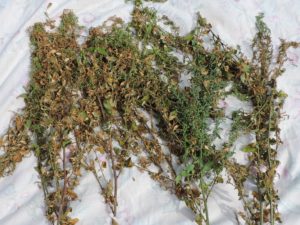
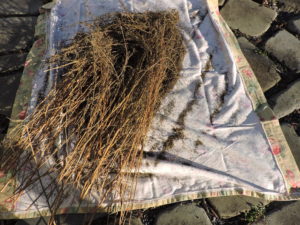
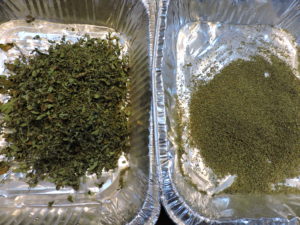
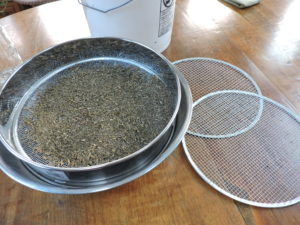
How to Store Prepared Seed: Once cleaned and fully dried, choose a low humidity day—not a rainy day—to jar up your seed.
Glass or metal works best, because all plastics are somewhat porous to humidity. Canning jars and lids work well. Place seed in a tightly sealed, glass container and store in a dark, cool area for up to 1 year. Refrigeration and freezing work well. Label the airtight container with the seed name, date of harvest and which animals it should be used for.
If you intend to keep the seed longer than one year, jar up the seeds in two stages. First, jar the seeds up using a desiccant for up to 1 week. Then check the seed for dryness, and if dry enough, remove the desiccant and immediately repack the seed into an airtight container. Read more about drying seeds and using desiccants here.
Keep stored seed in an airtight glass or metal container in a cool, dark place. Refrigeration and freezing works well, but allow container to warm to room temperature before opening. Discard any seed that ever appears moldy.
Rare Species in Virginia
Fogg’s goosefoot, the more endangered of the Virginia Chenopodiums, is found along the western counties of the Shenandoah Valley. It is the most likely lamb’s quarter to be misidentified with C. standleyanum. There’s no simple way to tell these two apart. If you limit your harvesting of lamb’s quarter to developed flatland areas such as fields, gardens, and open developed lots you will avoid accidentally harvesting Fogg’s goosefoot which is limited to wilder areas of mountain forests and woodlands.
Do you live in one of these Virginia counties? If so, be aware that there are some species near you that may be threatened or endangered. Do more research to make sure you are identifying your target species correctly and not harvesting a threatened species!
| County in Virginia | Species |
| Allegheny | Fogg’s goosefoot |
| Allegheny | mapleleaf goosefoot |
| Augusta | mapleleaf goosefoot |
| Bath | Fogg’s goosefoot |
| Bland | mapleleaf goosefoot |
| Botetourt | mapleleaf goosefoot |
| Carroll | mapleleaf goosefoot |
| Dickenson | mapleleaf goosefoot |
| Fairfax | mapleleaf goosefoot |
| Giles | Fogg’s goosefoot |
| Giles | mapleleaf goosefoot |
| Madison | mapleleaf goosefoot |
| Nelson | mapleleaf goosefoot |
| Page | mapleleaf goosefoot |
| Roanoke | mapleleaf goosefoot |
| Rockingham | Fogg’s goosefoot |
| Rockingham | mapleleaf goosefoot |
| Shenandoah | Fogg’s goosefoot |
| Wise | mapleleaf goosefoot |
| Wythe | mapleleaf goosefoot |
(Townsend, John F., 2015)
Feed Lamb’s Quarter to:
lamb's quarters | (Chenopodium album) | seeds |
|---|---|---|
Squirrel, American Red | Tamiasciurus hudsonicus |
|
Bunting, Snow | Plectrophenax nivalis | strong preference |
Redpoll, Common | Carduelis flammea | strong preference |
Grosbeak, Evening | Coccothraustes vespertinus |
|
Lark, Horned | Eremophila alpestris |
|
Longspur, Lapland | Calcarius lapponicus |
|
Sparrow, American Tree | Spizella arborea |
|
Sparrow, Chipping | Spizella passerina |
|
Sparrow, Field | Spizella pusilla |
|
Sparrow, House | Passer domesticus |
|
Sparrow, Lincoln's | Melospiza lincolnii |
|
Sparrow, Savannah | Passerculus sandwichensis |
|
Sparrow, Song | Melospiza melodia |
|
Sparrow, Vesper | Pooecetes gramineus |
|
Sparrow, White-crowned | Zonotrichia leucophrys |
|
Book References:
Elpel, T.J. (2013) Botany in a Day (APG). Pony, Montana: Hops Press, LLC.
Martin, A.C., Zim, H.S., Nelson, A.L. (1951). American Wildlife and Plants: A Guide to Wildlife Food Habits. New York: Dover Publications.
Scott, M. (2013). Songbird Diet Index. National Wildlife Rehabilitators Association, St. Cloud, MN.
Townsend, J. F. (2015, April) Rare Plants Natural Heritage Technical Report 15-10. (Unpublished Report) Richmond, Virginia: Virginia Department of Conservation and Recreation, Division of Natural Heritage.
Virginia Department of Forestry (2010). Common Native Trees of Virginia: Tree Identification Guide
Online References:
Aikman, Kevin E.,( 1987, January 1) Cyanogenic Plants of Illinois. Masters Theses. 2580. Retrieved July 17, 2017 from http://thekeep.eiu.edu/theses/2580
USDA, NRCS. 2015. The PLANTS Database (http://plants.usda.gov, 24 November 2015). National Plant Data Team, Greensboro, NC 27401-4901 USA.
Virginia Botanical Associates. (Accessed November 2015). Digital Atlas of the Virginia Flora (http://www.vaplantatlas.org). c/o Virginia Botanical Associates, Blacksburg.

